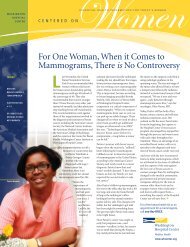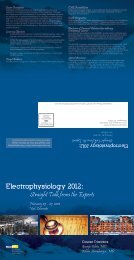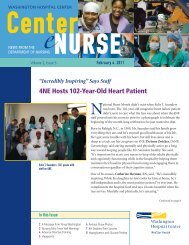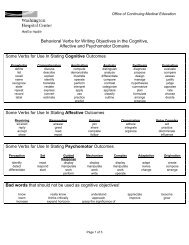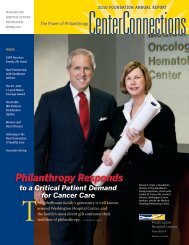Genetics of Diabetes
Genetics of Diabetes
Genetics of Diabetes
Create successful ePaper yourself
Turn your PDF publications into a flip-book with our unique Google optimized e-Paper software.
<strong>Genetics</strong> <strong>of</strong> <strong>Diabetes</strong><br />
Melissa Fries, MD<br />
Clinical Geneticist/Obstetrician-<br />
Gynecology
In your Jeans or your Genes?
Definition <strong>of</strong> genetics<br />
Study <strong>of</strong> inherited characteristics<br />
� Viewed in context <strong>of</strong> an individual and his/her<br />
family<br />
� Infinitely broad scope<br />
� Molecular genetics and the nature <strong>of</strong> genes<br />
� Medical genetics and the nature <strong>of</strong> illness<br />
� Clinical genetics and the diagnosis <strong>of</strong> disorders
Classic Medical <strong>Genetics</strong><br />
� Single gene disorders:<br />
� Over 3000<br />
� Often expressed in the pediatric population<br />
� Resources:<br />
� www.genetests.org<br />
� On-line Mendelian Inheritance in Man<br />
� www.ncbi.nlm.nih.gov/entrez/query.fcgi?db=OMIM<br />
� New Focus in <strong>Genetics</strong>: Complex common<br />
disease
Single gene abnormalities<br />
� Usually identified through a recognizable<br />
abnormality<br />
� “Treasure your exceptions”<br />
� Easier to recognize a visible abnormality than<br />
an abnormal gene<br />
� Inheritance patterns <strong>of</strong> these abnormalities is<br />
a clue to their genetic make-up and valuable<br />
to the family
Family inheritance patterns<br />
� Mendelian (single gene) disorders<br />
� Autosomal dominant<br />
� Autosomal recessive<br />
� X-linked<br />
� Multi-factorial disorders<br />
� Mitochondrial disorders<br />
� Abnormalities <strong>of</strong> mitochondrial DNA
Multifactorial inheritance<br />
� Condition is related to the interaction <strong>of</strong><br />
multiple genes and environmental factors<br />
� No predictable pattern <strong>of</strong> recurrence<br />
� Recurrence risks based on empiric data <strong>of</strong><br />
population studies<br />
� Usually is the square root <strong>of</strong> the population<br />
frequency--3-4%<br />
� Most likely involved in common, complex<br />
diseases such as diabetes
Multifactorial disorders<br />
� Higher recurrence risks if<br />
� more family members are affected<br />
� affected person is <strong>of</strong> the less commonly affected<br />
sex<br />
� more severe initial condition<br />
� Reduced recurrence risk with<br />
� more distant relationship (negligible in 3degree<br />
relatives)<br />
� Concerns to recognize both genetic<br />
predisposition AND environmental triggers
<strong>Diabetes</strong> mellitus<br />
� Extremely common disorder <strong>of</strong> glucose<br />
metabolism related to a failure <strong>of</strong> adequate<br />
insulin production<br />
� T1D: autoimmune destruction <strong>of</strong> beta cells<br />
� T2D: Impaired insulin effectiveness along<br />
with failure to produce adequate insulin<br />
� Affects over 18 million people in the US
Permutt,<br />
2005
Epidemiology <strong>of</strong> DM<br />
� Lifetime risk for development <strong>of</strong> DM<br />
� 33% for males<br />
� 39% for females<br />
� 53% for Hispanic females<br />
� Related also to age<br />
� 10 times more common >65 than
<strong>Genetics</strong> <strong>of</strong> T1D (10% <strong>of</strong> DM)<br />
� Disease requires predisposing genetic<br />
background and<br />
� Interaction with other environmental factors<br />
� End result: T cell mediated destruction <strong>of</strong> beta<br />
cells<br />
� Most cases are sporadic<br />
� No standard Mendelian pattern <strong>of</strong> inheritance<br />
� Susceptibility to disease, rather than disease itself<br />
appears to be inherited
Autoimmune triggers: T-cells<br />
may directly target insulin<br />
� Kent, et al Nature 435, 2005:<br />
� Examined T cells from pancreatic draining lymph<br />
nodes in diabetic patients with DR4 susceptability<br />
allele<br />
� Specific clone <strong>of</strong> T cells which recognized the<br />
insulin A1-15 epitope<br />
� Strongly supports autoimmune effect from<br />
stimulated T-cells
Autoimmune Triggers: GAD<br />
� Glutamic acid decarboxylase 1/2 (GAD 1 and<br />
2)<br />
� Catalyzes gamma aminobutyric acid from Lglutamic<br />
acid<br />
� Found to act as autoantigen in T1D as well as stiff<br />
person syndrome<br />
� Gene is at 10p11.23<br />
� 2 common isotypes: GAD65 and 67 in brain and<br />
pancreatic islet cells
Autoimmune effects<br />
� GAD 65<br />
� Shares 24 AA segment with P2-C protein <strong>of</strong><br />
coxsackie virus<br />
� 17 viruses identified with some homology to<br />
various segments <strong>of</strong> GAD65<br />
� De Aizpurua, 1992: anti-GAD found in most<br />
subjects with pre-clinical IDDM<br />
� Antibodies against common viruses may also<br />
target GAD<br />
� End result: gradual beta islet cell failure
Genetic predisposition: HLA<br />
genotypes<br />
� DR and DQ loci on chromosome 6p major<br />
genetic influences for T1D<br />
� DR1,3,4,8, and 2(16) increase susceptibility<br />
� DR 5 and 2(15) provide protection<br />
� DQ 0602 provides dominant protection against<br />
T1D<br />
� Strong susceptibility to narcolepsy
HLA genes<br />
Chromosome<br />
6p
HLA subtypes and<br />
susceptibility<br />
� Exaggerated susceptibility to T1D in<br />
DR3/DR4 heterozygotes<br />
� Appears to relate to production <strong>of</strong> unique<br />
hybrid molecules which lead to altered<br />
functional immune response in DR4 subtypes
Norwegian studies<br />
� One <strong>of</strong> the highest world frequencies <strong>of</strong> T1D<br />
� Ronningen, et al: <strong>Diabetes</strong>, 1997<br />
� Specific HLA genotype at high risk<br />
� DR4-DQ8/DR3-DQ2<br />
� Confers RR <strong>of</strong> 20 for T1D development<br />
� Absolute risk <strong>of</strong> 7% by age 15<br />
� In Norway, tested in neonatal screening<br />
� 2.1% <strong>of</strong> newborns carry this genotype
MIDIA study: Environmental<br />
Triggers <strong>of</strong> Type 1 <strong>Diabetes</strong><br />
� Rasmussen et al, <strong>Diabetes</strong> Care, 2009<br />
� Followed 1003 newborns screen positive (in 46,939<br />
newborns screened) for high risk genotype<br />
� 885 tested serially for autoantibodies to insulin, GAD, and<br />
insulinoma-associated protein 2<br />
� Followed for 6 years<br />
� 36 developed islet autoimmunity (4%)<br />
� 10 developed diabetes<br />
� Maternal BMI >30kg/m 2 and wt gain <strong>of</strong> >15 kg in pregnancy<br />
increased risk for islet autoimmunity in <strong>of</strong>fspring by 2-3fold<br />
� ?Increased maternal/fetal glucose may increase fetal insulin<br />
production and growth <strong>of</strong> islet cells
PANDA study<br />
� Prospective Assessment in Newborns for<br />
<strong>Diabetes</strong> Autoimmunity<br />
� NIH Observational study (still recruiting)<br />
� Initiated in early 2000<br />
� U <strong>of</strong> FL and Georgia<br />
� Evaluate risk for development <strong>of</strong> T1D<br />
� Measure genetic risk factors (HLA)<br />
� Autoimmunity markers<br />
� Family history
PANDA study<br />
� No diabetes outcome data reported yet<br />
� 3 published reports on psychosocial factors<br />
related to the study<br />
� Genet Med, 2003: 73% <strong>of</strong> mothers recall infant’s<br />
diabetes risk accurately<br />
� <strong>Diabetes</strong> Care, 2005: No overall increase in maternal<br />
depression regarding infant’s diabetes risk<br />
� Increased depression if mother is <strong>of</strong> ethnic minority, limited<br />
education, or with post partum depresssion<br />
� <strong>Diabetes</strong> Care, 2005: 67% <strong>of</strong> mothers <strong>of</strong> at risk<br />
infants reported 1 or more diabetes prevention<br />
behaviors
Single nucleotide polymorphism<br />
(SNP) studies<br />
� European Consortium for IDDM Genome<br />
studies<br />
� Identified susceptibility loci on 2p, 5q, 16p<br />
� Suggest non-HLA genes also involved<br />
� Interaction between HLA and non-HLA loci may be<br />
etiologic<br />
� No clear pattern at this time
Family risk for T1D(Schatz and Winter,<br />
Current opinions in Pediatrics, 1995; 7:459-465)<br />
General population .2%<br />
Any 1 st degree relative 5%<br />
Sibling: no HLA shared 1-2%<br />
1 HLA haplotype shared 5-7%<br />
2 HLA haplotypes shared 16-17 %<br />
Both HLA haplotypes 20-25%<br />
DR3/DR4<br />
Monozygotic twins 33%
Other genes involved<br />
� CTLA4 cytoxic T-lymphocyte associated<br />
protein 4<br />
� PTPN22 Protein tyrosine phosphate nonreceptor<br />
type 22<br />
� INS (Variable number <strong>of</strong> tandem repeats)<br />
� Permutt, J Clin Invest, Vol 115(6), June 2005:<br />
1431-1439
T2D (90% <strong>of</strong> DM)<br />
� Increase in frequency follows increase in<br />
obesity, urbanization, and wealth<br />
� “Thrifty genotype” postulated<br />
� Genetic advantage <strong>of</strong> accelerated fat deposition in<br />
time <strong>of</strong> restricted calories<br />
� Disadvantage in time <strong>of</strong> unrestricted calories<br />
� “Thrifty phenotype” (Barker hypothesis)<br />
� Malnourishment (IUGR) leads to impaired beta cell<br />
development, insulin resistance, and predisposition to<br />
adult diabetes and metabolic syndrome
<strong>Genetics</strong> <strong>of</strong> T2D<br />
� Still very poorly understood<br />
� May relate to susceptibility issues to obesity as<br />
well as insulin resistance<br />
� Combined inherited/environmental features<br />
not well understood
Triggers: Obesity<br />
� Sargeant, NIH, 2003: 38% <strong>of</strong> the excess risk<br />
associated with a family history <strong>of</strong> diabetes<br />
could be avoided if BMI was not allowed to<br />
be greater than 30kg/m 2 .<br />
� However, relatives <strong>of</strong> non-obese T2D may<br />
have greater risk for disease development<br />
� Implies possible greater genetic burden if disease<br />
development in absence <strong>of</strong> obesity
Obese<br />
Not Obese<br />
Goldfine, Proc Nat Aca Sci, 2003<br />
Fm Hx <strong>Diabetes</strong><br />
<strong>Diabetes</strong><br />
development:<br />
16.7/1000<br />
person years<br />
<strong>Diabetes</strong><br />
development:<br />
8.8/1000 person<br />
years<br />
No family Hx <strong>of</strong><br />
<strong>Diabetes</strong><br />
<strong>Diabetes</strong><br />
development:<br />
1.8/1000 person<br />
years<br />
<strong>Diabetes</strong><br />
development:<br />
1.6/1000 person<br />
years
Possible Genes associating<br />
with T2D<br />
� Genes involved in insulin secretion<br />
� ABCC8 (sulfonylurea receptor) and KCNJ11<br />
� Components <strong>of</strong> the K ATP channel on beta cells<br />
� Uncoupling protein UCP2<br />
� Mitochondrially encoded NADH dehydrogenase<br />
� Variants will be inherited only maternally<br />
� Transcription factor 7-like 2 (TCF7L2)
Possible Genes associating<br />
with T2D<br />
� Insulin and Insulin signaling genes<br />
� INS insulin gene<br />
� Insulin receptor (INSR)<br />
� Insulin-like growth factor IGF2(adjacent to INS gene)<br />
� Insulin receptor substrate IRS1<br />
� Note: All studied changes are related to<br />
polymorphisms—variations in sequence not<br />
associated with protein malformation or absence but<br />
which may vary protein efficiency or adaptation<br />
� Defects in insulin expression or insulin receptor expression<br />
would probably be lethal.
Possible Genes associating<br />
with T2D<br />
� Lipid and glucose metabolism genes<br />
� Peroxisome proliferative activated receptor<br />
gamma (PPARG)<br />
� Transcription factor which regulates adipocyte<br />
development as well as lipid and glucose metabolism<br />
� Common variant: Pro12Ala (substitutes alanine for<br />
proline) which alters binding affinity<br />
� Confers moderately increased risk for T2D<br />
� May also influence obesity
Possible Genes associating<br />
with T2D<br />
� Peroxisome proliferative activated receptor-gamma<br />
coactivator 1-alpha (PPARGC1A)<br />
� Beta 3 adrenergic receptor<br />
� Glucose transporter 1<br />
� Adiponectin<br />
� Forkhead box C2 (FOXC2)<br />
� Mannose-binding lectin (protein C)2<br />
� Calpain 10<br />
� Plasminogen activator inhibitor type 1
MODY-maturity onset diabetes<br />
<strong>of</strong> the young<br />
� Early onset T2D less than age 25 in non-obese<br />
patients<br />
� Defects in insulin secretion<br />
� AD inheritance pattern, 2-5% <strong>of</strong> T2D<br />
� Different subtypes related to different genes<br />
� HNF4alpha (hepatocyte nuclear factor): 5%<br />
� GCK (glucokinase) 12.5%<br />
� HNF1A(hepatocyte nuclear factor 1a): 65%<br />
� IPF1<br />
� HNF1B<br />
� NEU-ROD1<br />
� Genetic testing available
Genetests.org search for genetic testing for <strong>Diabetes</strong> mellitus<br />
Search Result for Disease Name Containing 'diabetes mellitus'<br />
ABCC8-Related Transient Neonatal <strong>Diabetes</strong> Mellitus 2<br />
<strong>Diabetes</strong> Mellitus, 6q24-Related Transient Neonatal<br />
<strong>Diabetes</strong> Mellitus, Insulin-Resistant, with Acanthosis Nigricans<br />
<strong>Diabetes</strong> Mellitus, KCNJ11-Related Transient Neonatal<br />
<strong>Diabetes</strong> Mellitus, Neonatal, with Congenital Hypothyroidism<br />
<strong>Diabetes</strong> Mellitus, Noninsulin-Dependent, with Acanthosis Nigricans and Hypertension<br />
<strong>Diabetes</strong> Mellitus, Permanent Neonatal, with Cerebellar Agenesis<br />
Maturity-Onset <strong>Diabetes</strong> <strong>of</strong> the Young Type 1 [<strong>Diabetes</strong> Mellitus, MODY Type 1]<br />
More Links<br />
HNF4A-Related Maturity-Onset <strong>Diabetes</strong> <strong>of</strong> the Young Type 1 [HNF4A-Related <strong>Diabetes</strong> Mellitus, MODY Type<br />
1]<br />
More Links<br />
INS-Related Maturity-Onset <strong>Diabetes</strong> <strong>of</strong> the Young Type 1 [INS-Related <strong>Diabetes</strong> Mellitus, MODY Type<br />
1]<br />
More Links<br />
Maturity-Onset <strong>Diabetes</strong> <strong>of</strong> the Young Type 2 [<strong>Diabetes</strong> Mellitus, MODY Type 2]<br />
Links<br />
Maturity-Onset <strong>Diabetes</strong> <strong>of</strong> the Young Type 3 [<strong>Diabetes</strong> Mellitus, MODY Type 3]<br />
Maturity-Onset <strong>Diabetes</strong> <strong>of</strong> the Young Type 4 [<strong>Diabetes</strong> Mellitus, MODY Type 4]<br />
Maturity-Onset <strong>Diabetes</strong> <strong>of</strong> the Young Type 6 [<strong>Diabetes</strong> Mellitus, MODY Type 6]<br />
Multiple Epiphyseal Dysplasia with Early-Onset <strong>Diabetes</strong> Mellitus<br />
Permanent Neonatal <strong>Diabetes</strong> Mellitus<br />
ABCC8-Related Permanent Neonatal <strong>Diabetes</strong> Mellitus<br />
GCK-Related Permanent Neonatal <strong>Diabetes</strong> Mellitus<br />
INS-Related Permanent Neonatal <strong>Diabetes</strong> Mellitus<br />
KCNJ11-Related Permanent Neonatal <strong>Diabetes</strong> Mellitus<br />
PDX1-Related Permanent Neonatal <strong>Diabetes</strong> Mellitus<br />
Pineal Hyperplasia, Insulin-Resistant <strong>Diabetes</strong> Mellitus, and Somatic Abnormalities<br />
Renal Cysts and <strong>Diabetes</strong> Syndrome [<strong>Diabetes</strong> Mellitus, MODY Type 5]<br />
Items 1 - 16 <strong>of</strong> 16<br />
More Links<br />
More Links<br />
More Links<br />
More Links<br />
More Links<br />
More Links<br />
More Links<br />
More Links<br />
More Links<br />
More Links<br />
More Links<br />
More Links<br />
More Links<br />
More Links<br />
More Links<br />
More Links<br />
More Links<br />
More Links<br />
More Links<br />
More
Family Risk for T2D (Groop, J Int Med 1997:<br />
241:95-101)<br />
Offspring <strong>of</strong> one parent with<br />
T2D<br />
Offspring <strong>of</strong> two parents with<br />
T2D<br />
Siblings <strong>of</strong> individuals with<br />
T2D<br />
Monozygotic twins<br />
concordancy<br />
40% lifetime risk<br />
80-100% lifetime risk<br />
35% lifetime risk<br />
70-80%*<br />
May be 100% if index<br />
case has disease onset<br />
after age 45
<strong>Genetics</strong> <strong>of</strong> Diabetic<br />
nephropathy<br />
� Diabetic nephropathy is a subtype, affecting<br />
1/3 <strong>of</strong> those with T1D after 40 years<br />
� Familial aggregation seen in those with diabetic<br />
nephropathy<br />
� Black ethnicity and early onset <strong>of</strong> ESRD also clustered<br />
� Genome wide linkage scans survey genome<br />
for regions coinherited with a trait<br />
� Linkage found to 7q35,3q26,9q22,20p12
Special inheritance pattern in<br />
diabetes<br />
� Mitochondrial effects
Mitochondrial Inheritance<br />
� Occurs from mutation in mitochondrial DNA<br />
� circular double stranded DNA found in multiple<br />
copies in each mitochondrion<br />
� Mitochondria are tiny energy producing<br />
organelles <strong>of</strong> the cell<br />
� 1000’s in each cell<br />
� Passed in the cytoplasm <strong>of</strong> the ovum<br />
� Exclusive maternal transmission<br />
� If mother is affected, disease is passed to all her<br />
<strong>of</strong>fspring
Mitochondrial Inheritance<br />
� Displays heteroplasmy<br />
� Different mitochondria may or may not have the<br />
mutation<br />
� Severity <strong>of</strong> disease is proportional to the relative<br />
proportions <strong>of</strong> normal and abnormal mitochondrial<br />
DNA<br />
� Affected males cannot transmit the disease<br />
� Affected females transmit to all their children
Mitochondrial disease in<br />
diabetes<br />
� MIDD: Maternally inherited diabetes and<br />
deafness<br />
� Mutation in mitochondrial DNA (3243tRNA leu)<br />
� Same mutation associated with MELAS<br />
� Mitochondrial myopathy, encephalopathy, lactic<br />
acidosis, and stroke-like episodes<br />
� Usually not obese, with deafness preceding DM<br />
� Appears to lead to defect in insulin release
Gestational diabetes<br />
� Permutt, 2005<br />
� Gestational diabetes is “state <strong>of</strong> glucose<br />
intolerance in pregnancy . . . With major<br />
implications for subsequent development <strong>of</strong> T2D<br />
as pregnancy serves as an ‘environmental<br />
stressor’ that reveals a genetic predisposition.”
Genetic susceptibility to GDM<br />
� Any parental history <strong>of</strong> T2D diabetes<br />
increases risk for GDM 2.3x<br />
� Mothers with a diabetic sibling have 8.4 fold<br />
higher risk <strong>of</strong> GDM than women with no<br />
diabetic siblings<br />
� Lifetime risk for T2D after having GDM is 15-<br />
60%
What is the heritability for<br />
GDM?<br />
� May relate to epigenetic changes in the in-utero environment<br />
leading to future predisposition<br />
� Epigenetic changes: Changes in gene activation or suppression<br />
by methylation <strong>of</strong> DNA or deacetylation <strong>of</strong> histones—not DNA<br />
sequence changes<br />
� 2 older studies showing that GDM is more frequent in the<br />
mothers <strong>of</strong> women who themselves later develop GDM<br />
� Also greater likelihood for GDM in women whose mothers, not<br />
fathers have T2D<br />
� No paternal or maternal influence seen in T1D parents for GDM<br />
� Implication that prenatal exposure to diabetic intrauterine<br />
environment may lead to increased predisposition to GDM in<br />
adult pregnant state
Effects <strong>of</strong> Gestational <strong>Diabetes</strong><br />
on <strong>of</strong>fspring<br />
� J MatFetNeonatal Med, 2008: Vohr,et al<br />
� Pediatrics, 2004, Boney et al<br />
� Development <strong>of</strong> metabolic syndrome in children<br />
related to<br />
� Maternal gestational diabetes mellitus<br />
� Maternal glycemia in the 3 rd trimester<br />
� Maternal obesity<br />
� Neonatal macrosomia<br />
� Perpetuating cycle <strong>of</strong> increasing obesity, insulin<br />
resistance and abnormal lipid metabolism
Relationship <strong>of</strong> GDM and T2D<br />
� Parallels in inheritance features and increase<br />
in lifetime risk for T2D after GDM suggests<br />
probable common variants in genes<br />
predisposing to both
<strong>Genetics</strong> <strong>of</strong> Common<br />
Disorders<br />
� Key research effort at present<br />
� <strong>Diabetes</strong> high on priorities <strong>of</strong> studies<br />
� Research to investigate<br />
� Complications<br />
� Pharmacogenetics<br />
� Environmental triggers<br />
� Etiologic factors
Suggested references<br />
� Robitaille, J and Grant AM. The genetics <strong>of</strong><br />
gestational diabetes mellitus. Genet Med<br />
2008, 10(4):240-250<br />
� Permutt MA, Wasson J, and Cox N. Genetic<br />
epidemiology <strong>of</strong> diabetes. J Clin Invest,<br />
2005, 115(6): 1431-1439.<br />
� Newell AM. <strong>Genetics</strong> for targeting disease<br />
prevention: diabetes. Primary Care: Clinics in<br />
Office Practice 2004, 31(3)
Jeans or Genes?<br />
� Genes In Jeans!







